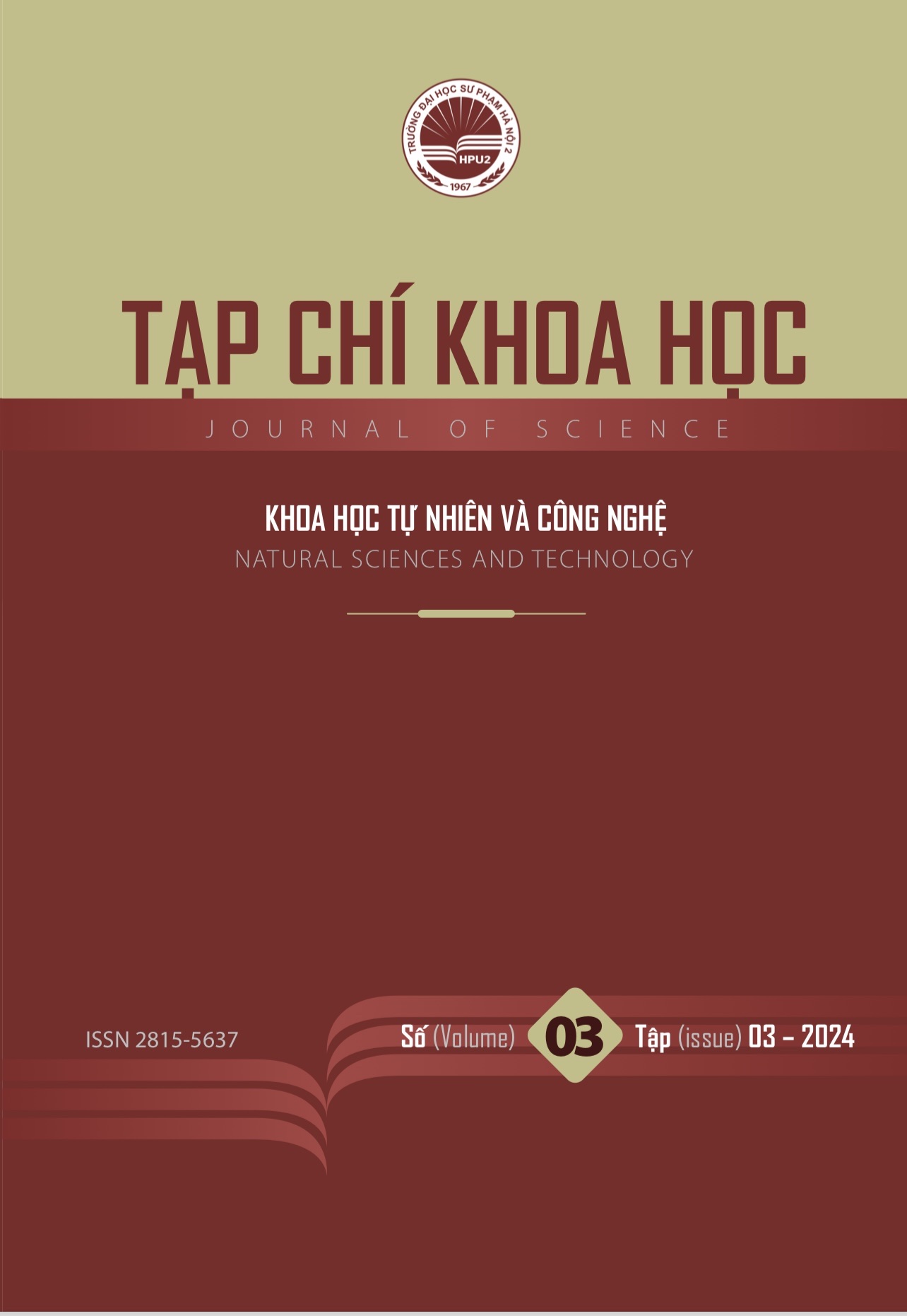An investigation into the morphological and anatomical characteristics of three cassava (\( Manihot \,\, esculenta\)) varieties collected from the Northern provinces of Vietnam
DOI:
https://doi.org/10.56764/hpu2.jos.2024.3.3.43-51Abstract
Cassava (Manihot esculenta Crantz) is a crucial crop that sustains millions of people across tropical and subtropical regions, providing an essential source of carbohydrates and contributing significantly to food security. Morphologically, varieties KM94, 08SA06, and Ruột vàng exhibit distinct traits such as plant form, leaf structure, tuber shape, and starch content, which underline their adaptability and potential for high yield under diverse growing conditions. Anatomically, the stems of these varieties demonstrate unique structural features, including tightly packed epidermal cells with thick cuticle layers, varying layers of collenchyma and parenchyma, robust sclerenchyma rings, and well-organized vascular bundles. These features ensure efficient nutrient and water transport, structural integrity, and resilience against environmental stresses, essential for the growth and development of these cassava varieties. By highlighting these morphological and anatomical traits, this study emphasizes the importance of such detailed analyses for improving cassava cultivation practices.
References
[1] K. M. Olsen and B. A. Schaal, “Evidence on the origin of cassava: Phylogeography of Manihot esculenta,” Proc. Natl. Acad. Sci. U.S.A., vol. 96, no. 10, pp. 5586–5591, May 1999, doi: 10.1073/pnas.96.10.5586.
[2] F. Guira, K. Some, D. Kabore, H. Sawadogo‐Lingani, Y. Traore, and A. Savadogo, “Origins, production, and utilization of cassava in Burkina Faso, a contribution of a neglected crop to household food security,” Food Sci. Nutr., vol. 5, no. 3, pp. 415–423, Jul. 2016, doi: 10.1002/fsn3.408.
[3] S. R. N. S. P. Mohidin, S. Moshawih, A. Hermansyah, M. I. Asmuni, N. Shafqat, and L. C. Ming, “Cassava (Manihot esculenta Crantz): A systematic review for the pharmacological activities, traditional uses, nutritional values, and phytochemistry,” J. Evid.-Based Integr. Med., vol. 28, Otc. 2023, doi: 10.1177/2515690x231206227.
[4] N. K. Morgan and M. Choct, “Cassava: Nutrient composition and nutritive value in poultry diets,” Anim. Nutr., vol. 2, no. 4, pp. 253–261, Sep. 2016, doi: 10.1016/j.aninu.2016.08.010.
[5] P. Zhao et al., “Analysis of different strategies adapted by two cassava cultivars in response to drought stress: Ensuring survival or continuing growth,” J. Exp. Bot., vol. 66, no. 5, pp. 1477–1488, Dec. 2014, doi: 10.1093/jxb/eru507.
[6] M. C. Wilson et al., “Gene expression atlas for the food security crop cassava,” New Phytol., vol. 213, no. 4, pp. 1632–1641, Jan. 2017, doi: 10.1111/nph.14443.
[7] A. I. Malik et al., “Cassava breeding and agronomy in Asia: 50 years of history and future directions,” Breed. Sci., vol. 70, no. 2, pp. 145–166, Jan. 2020, doi: 10.1270/jsbbs.18180.
[8] T. T. T. Hanh et al., “Vietnam climate change and health vulnerability and adaptation assessment, 2018,” Environ. Health Insights, vol. 14, Jun. 2020, Art. no. 1178630220924658, doi: 10.1177/1178630220924658.
[9] M. E. Ferguson et al., “Collection and characterization of cassava germplasm in Comoros,” Genet. Resour. Crop Evol., vol. 71, no. 1, pp. 341–361, Jun. 2023, doi: 10.1007/s10722-023-01626-4.
[10] J. Shi, G. An, A. P. M. Weber, and D. Zhang, “Prospects for rice in 2050,” Plant Cell Environ., vol. 46, no. 4, pp. 1037–1045, Feb. 2023, doi: 10.1111/pce.14565.
[11] L. V. Da Conceicão, D. F. M. Cortes, D. Klauser, M. Robinson, and E. J. De Oliveira, “New protocol for rapid cassava multiplication in field conditions: A perspective on speed breeding,” Front. Plant Sci., vol. 14, Sep. 2023, Art. no. 1258101, doi: 10.3389/fpls.2023.1258101.
[12] Q. Zhou et al., “Integrated analysis of morphological, physiological, anatomical and molecular responses of cassava seedlings to different light qualities,” Int. J. Mol. Sci., vol. 24, no. 18, Sep. 2023, Art. no. 14224, doi: 10.3390/ijms241814224.
[13] C. C. D. Santos, L. R. B. De Andrade, C. D. D. Carmo, and E. J. De Oliveira, “Development of cassava core collections based on morphological and agronomic traits and SNPS markers,” Front. Plant Sci., vol. 14, Sep. 2023, Art. no. 1250205, doi: 10.3389/fpls.2023.1250205.
[14] C. T. Rueden et al., “ImageJ2: ImageJ for the next generation of scientific image data,” BMC Bioinform., vol. 18, Nov. 2017, Art. no. 529, doi: 10.1186/s12859-017-1934-z.
[15] D. Graciano-Ribeiro, D. Y. Hashimoto-Freitas, and N. M. A. Nassar, “Comparative petiole anatomy of cassava (Manihot) species,” Genet. Mol. Res., vol. 15, no. 1, Jan. 2016, Art. no. gmr.15017495, doi: 10.4238/gmr.15017495.
[16] Z. Cai et al., “Morphological, anatomical, and transcriptomics analysis reveals the regulatory mechanisms of cassava plant height development,” BMC Genom., vol. 25, no. 1, Jul. 2024, Art. no. 699, doi: 10.1186/s12864-024-10599-2.
[17] G. Schroth, P. Läderach, A. I. Martinez-Valle, C. Bunn, and L. Jassogne, “Vulnerability to climate change of cocoa in West Africa: Patterns, opportunities and limits to adaptation,” Sci. Total Environ., vol. 556, pp. 231–241, Mar. 2016, doi: 10.1016/j.scitotenv.2016.03.024.
[18] R. Diaguna et al., “Morphological and physiological characterization of cassava genotypes on dry land of ultisol soil in Indonesia,” Int. J. Agron., vol. 2022, May 2022, Art. no. 3599272, doi: 10.1155/2022/3599272.
[19] N. M. A. Nassar, L. F. A. Abreu, D. A. P. Teodoro, and D. Graciano-Ribeiro, “Drought tolerant stem anatomy characteristics in Manihot esculenta (Euphorbiaceae) and a wild relative,” Genet. Mol. Res., vol. 9, no. 2, pp, 1023–1031, Jan. 2010, doi: 10.4238/vol9-2gmr800.
[20] N. N. Bomfim, D. Graciano-Ribeiro, and N. M. A. Nassar, “Genetic diversity of root anatomy in wild and cultivated Manihot species,” Genet. Mol. Res., vol. 10, no. 2, pp. 544–551, Jan. 2011, doi: 10.4238/vol10-2gmr1093.
Downloads
Published
How to Cite
Volume and Issue
Section
Copyright and License
Copyright (c) 2024 Van-Tien Tran, Kim-Tien Nguyen Thi, Lan-Huong Do Thi

This work is licensed under a Creative Commons Attribution-NonCommercial 4.0 International License.




